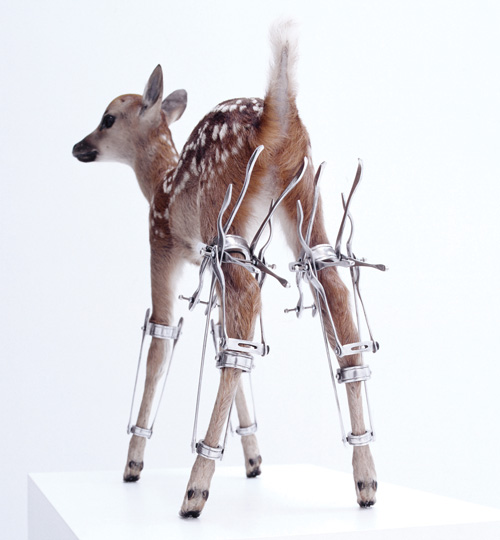If you’re unfamiliar with the term “phantom limb,” it describes the sensation sometimes experienced by amputees that their lost limb is still attached to their body. The missing limb may itch or ache; regardless of the fact that the sensation is entirely in the brain, it feels very real. It is this ability of the mind to recreate missing things that interests Motohiko Odani, and the reason why his retrospective at the Mori Art Museum takes the phenomenon as its title.
This particular incarnation of “Phantom Limb” could be cause for deja vu. In 1997 the sculptor’s first solo show had exactly the same title. Now that he has revived it as a part of his largest retrospective, it’s tempting to wonder if Odani feels that he is somehow closing a circle. The exhibition even begins and ends with works that were on display in ’97. But the content in-between reads like a careful essay with everything neatly circling back to that idea of sensing rather than seeing.
Much has been made of Odani’s self-proclaimed interest in pain, yet discussing it has always risked making him sound like an anguished art student. Seeing his taxidermied fawn — all four of its legs fitted with metal braces — is less about pain and cruelty than it is about the empathy that the viewer brings to the image. It is the audience that fills in the blanks: broken or deformed bones, an accident perhaps. It’s a topic that Odani himself has shown himself to have a sense of humor about. In one video work, he puts on a Leatherface mask and, aping the chainsaw wielding killer from the movie “Texas Chainsaw Massacre”, gleefully attacks a chunk of wood, a reference to his claim that using bones, teeth and taxidermied animals in sculpture is no different than using dead trees.
Odani has never tied himself to one medium or even one practice, so the show includes a considered selection of sculpture, with generous helpings of video, installation and photography. At the heart of it, however, are two major collections: his “SP2 ‘Newborn’” series and “Hollow” series, each with its own devoted room. The “SP2 ‘Newborn’” works consist of carved wooden models of animal bones, which Odani has set together in twisting, spine-like structures: a lily-like mouth filled with sharp, curving snake teeth; an undulating, flat-bodied thing that seems built for the ocean, and a writhing mass of snake bodies made of mouse skulls. The prey has become the predator, but is headless, or all heads, depending on how you look at it.
In the “Hollow” series, Odani goes the opposite direction. Rather than working with the skeleton, he hints at surface and movement. Two bodies frozen in mid-air seem to fall away from one another; a strangely impassive girl rides a ghostly unicorn. Like the “SP2 ‘Newborn’” series, it is the movement and missing bodies that the audience must perceive. The skeletons and the hollow ghost-like specters are reminders of death, but the viewer fills these phantoms with life.
The show comes to a close with a video of Odani’s work from the first incarnation of “Phantom Limb,” in which soap bubbles, each containing a few drops of the artist’s blood, float gently against a white wall and pop, leaving beautiful red-brown patterns that gradually become a gory mess. It strikes me that this is a fitting end — a new work made from an old installation, which gracefully and powerfully illustrates the tension that Odani has put so much of himself into creating. (Owen Schaefer)
Exhibition: ” Motohiko Odani: Phantom Limb”
(till Feb. 27)
Venue: Mori Art Museum
(Roppongi Station)
Hours: 10 am–10 pm (till 7pm on Tues.)
Admission: ¥1,500
More info: Visit www.mori.art.museum
or call (03) 5777-8600









